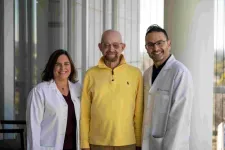(Press-News.org) Maryam Shanechi, Dean’s Professor of Electrical and Computer Engineering and founding director of the USC Center for Neurotechnology, and her team have developed a new machine learning method that reveals surprisingly consistent intrinsic brain patterns across different subjects by disentangling these patterns from the effect of visual inputs.The work has been published in the Proceedings of the National Academy of Sciences (PNAS).
When performing various everyday movement behaviors, such as reaching for a book, our brain has to take in information, often in the form of visual input — for example, seeing where the book is. Our brain then has to process this information internally to coordinate the activity of our muscles and perform the movement. But how do millions of neurons in our brain perform such a task? Answering this question requires studying the neurons’ collective activity patterns, but doing so while disentangling the effect of input from the neurons’ intrinsic (aka internal) processes, whether movement-relevant or not.
That’s what Shanechi, her PhD student Parsa Vahidi, and a research associate in her lab, Omid Sani, did by developing a new machine-learning method that models neural activity while considering both movement behavior and sensory input.
“Prior methods for analyzing brain data have either considered neural activity and input but not behavior, or considered neural activity and behavior but not input,” Shanechi said. “We developed a method that can consider all three signals — neural activity, behavior, and input — when extracting hidden brain patterns. This allowed us to not only disentangle input-related and intrinsic neural patterns, but also separate out which intrinsic patterns were related to movement behavior and which were not.”
Shanechi and her team used this method to study three publicly available datasets, during which three different subjects performed one of two distinct movement tasks, consisting of moving a cursor on a computer screen over a grid or moving it sequentially to random locations.
“When using methods that did not consider all three signals, the patterns found in neural activity of these three subjects looked different.” Vahidi said. But when the team used the new method to consider all three signals, a remarkably consistent hidden pattern emerged from neural activity of all three subjects that was relevant to movement. This similarity was despite the fact that the tasks performed by the three subjects were also different.
“In addition to revealing this new consistent pattern, the method also improved the prediction of neural activity and behavior compared to when all three signals were not considered during machine learning, as in prior work.” Sani said. “The new method enables researchers to more accurately model neural and behavioral data by accounting for various measured inputs to the brain, such as sensory inputs as in this work, electrical or optogenetic stimulation, or even input from different brain areas.”
This method and the discovered pattern can help understand how our brains perform movements, guided by the information we receive from the external world. Further, by modeling the effect of input and separating out intrinsic patterns that are behavior-relevant, this method can help develop future brain-computer interfaces that regulate abnormal brain patterns in disorders such as major depression by optimizing external inputs such as deep brain stimulation therapy.
“We are excited about how this algorithm could facilitate both scientific discoveries and the development of future neurotechnologies for millions of patients with neurological or neuropsychiatric disorders,” Shanechi said.
END
New algorithm disentangles intrinsic brain patterns from sensory inputs
USC researchers unmask consistent intrinsic brain patterns across different subjects.
2024-02-14
ELSE PRESS RELEASES FROM THIS DATE:
A new test could predict how heart attack patients will respond to mechanical pumps
2024-02-14
Every year, around 50,000 people in the United States experience cardiogenic shock — a life-threatening condition, usually caused by a severe heart attack, in which the heart can’t pump enough blood for the body’s needs.
Many of these patients end up receiving help from a mechanical pump that can temporarily help the heart pump blood until it recovers enough to function on its own. However, in nearly half of these patients, the extra help leads to an imbalance between the left and right ventricles, which can pose danger to the patient.
In a ...
Turning back the clock on photoaging skin
2024-02-14
Chronic exposure of human skin to ultraviolet light causes premature aging, or photoaging. As the skin undergoes photoaging, type I collagen bundles, which are found in the dermis beneath the top layer of the skin and provide strength and support to skin, become fragmented. This leads to wrinkles, fragility and loss of support and elasticity.
“The best way to prevent damage to type I collagen by sunlight is to wear sunscreen consistently, daily if possible and particularly when spending time outdoors,” said Frank Wang, MD, the William B. Taylor Endowed Professor of Clinical Dermatology at U-M Medical School.
Experts ...
City of Hope research featuring the successful treatment of the oldest patient to achieve remission for leukemia and HIV published in The New England Journal of Medicine (NEJM)
2024-02-14
LOS ANGELES — City of Hope®, one of the largest cancer research and treatment organizations in the United States, treated the oldest person to be cured of a blood cancer and then achieve remission for HIV after receiving a blood stem cell transplant from a donor with a rare genetic mutation. Research published in NEJM today demonstrates that older adults with blood cancers who receive reduced intensity chemotherapy before a stem cell transplant with donor cells that are resistant to HIV may be cured of HIV infection.
Paul Edmonds, 68, of Desert Springs, California, is the fifth person in the world to achieve remission for acute myelogenous leukemia ...
A lighthouse in the Gobi desert
2024-02-14
Los Angeles, CA (February 14, 2024) — A new study published in the journal PLOS ONE explores the weight great fossil sites have on our understanding of evolutionary relationships between fossil groups—the lagerstätten effect—and for the first time, quantified the power these sites have on our understanding of evolutionary history. Surprisingly, the authors discovered that the wind-swept sand deposits of the Late Cretaceous Gobi Desert’s extraordinarily diverse and well-preserved ...
Paradigm Shift: How a risk-based program is changing health care use and outcomes for children with high-risk asthma
2024-02-14
Le Bonheur’s risk-based innovation program Changing High-Risk Asthma in Memphis through Partnership (CHAMP) significantly decreased health care use related to asthma by targeting barriers to asthma care, according to research published in the Annals of Allergy, Asthma & Immunology. After one year of enrollment in the program, results analyzing 945 children included a 48% reduction in Emergency Department (ED) visits, 68% reduction in inpatient and observation visits, 42% reduction in urgent care visits and 53% reduction in asthma exacerbations. Asthma exacerbations per patient significantly decreased from 2.97 to 1.4.
“Children ...
U of M research advances potential HIV cure strategy
2024-02-14
Published in the Journal of Infectious Diseases Oxford Academic, research led by the University of Minnesota Medical School offers a new avenue of hope in the fight against chronic human immunodeficiency virus (HIV) infection.
The researchers explored the use of Natural Killer (NK) cells aiming to restore their function for better infection control — an approach that could be used in a broader HIV cure strategy as multiple companies are working on mass production of healthy NK cells.
“HIV has really excellent therapies thanks to the unprecedented progress in developing antiretroviral therapy, ...
New review finds Indigenous people more likely to have a stroke
2024-02-14
EMBARGOED FOR RELEASE UNTIL 4 P.M. ET, WEDNESDAY, FEBRUARY 14, 2024
MINNEAPOLIS – Indigenous people may be more likely to have a stroke than non-Indigenous people, according to a systematic review that looked at populations around the world. The review is published in the February 14, 2024, online issue of Neurology®, the medical journal of the American Academy of Neurology.
Researchers looked at countries with a very high Human Development Index, which measures average achievements in three areas: health, knowledge ...
UC Irvine-led research team creates novel rabies viral vectors for neural circuit mapping
2024-02-14
Irvine, Calif., Feb. 14, 2024 — A research team led by the University of California, Irvine has created 20 new recombinant rabies viral vectors for neural circuit mapping that offer a range of significant advantages over existing tools, including the ability to detect microstructural changes in models of aging and Alzheimer’s disease brain neurons.
The study published today online in the journal Molecular Psychiatry, introduced proof-of-concept data demonstrating the power of these new vectors, which express a range of improved ...
Broad Institute 2024 Media Boot Camp
2024-02-14
The Broad Institute of MIT and Harvard is now accepting applications for its 2024 Media Boot Camp.
This annual program connects health/science journalists and editors with faculty from the Broad Institute, Massachusetts Institute of Technology, Harvard University, and Harvard’s teaching hospitals for a two-day event exploring the latest advances in genomics and biomedicine. Journalists will explore possible future storylines, gain fundamental background knowledge, and build relationships with researchers. The program format ...
MEDIA ADVISORY: Mount Sinai doctors to present new research at 2024 SMFM Annual Pregnancy Meeting
2024-02-14
(New York, NY – February 9, 2024) – High-risk pregnancy specialists from the Mount Sinai Health System are presenting research at the Annual Pregnancy Meeting of the Society for Maternal-Fetal Medicine (SMFM) in Fort Washington, MD from February 10-14. Mount Sinai experts are available for interview about their research findings, and can also provide commentary on other women’s health topics, breaking news, and studies.
PRESENTATIONS and POSTER SESSIONS
(*All abstracts are under embargo until the below listed times*)
Sunday, February 11, 2024
FGR prevention: Is there a role for aspirin, heparin, ...
LAST 30 PRESS RELEASES:
Heart-brain connection: international study reveals the role of the vagus nerve in keeping the heart young
Researchers identify Rb1 as a predictive biomarker for a new therapeutic strategy in some breast cancers
Survey reveals ethical gaps slowing AI adoption in pediatric surgery
Stimulant ADHD medications work differently than thought
AI overestimates how smart people are, according to HSE economists
HSE researchers create genome-wide map of quadruplexes
Scientists boost cell "powerhouses" to burn more calories
Automatic label checking: The missing step in making reliable medical AI
Low daily alcohol intake linked to 50% heightened mouth cancer risk in India
American Meteorological Society announces Rick Spinrad as 2026 President-Elect
Biomass-based carbon capture spotlighted in newly released global climate webinar recording
Illuminating invisible nano pollutants: advanced bioimaging tracks the full journey of emerging nanoscale contaminants in living systems
How does age affect recovery from spinal cord injury?
Novel AI tool offers prognosis for patients with head and neck cancer
Fathers’ microplastic exposure tied to their children’s metabolic problems
Research validates laboratory model for studying high-grade serous ovarian cancer
SIR 2026 delivers transformative breakthroughs in minimally invasive medicine to improve patient care
Stem Cell Reports most downloaded papers of 2025 highlight the breadth and impact of stem cell research
Oxford-led study estimates NHS spends around 3% of its primary and secondary care budget on the health impacts of heat and cold in England
A researcher’s long quest leads to a smart composite breakthrough
Urban wild bees act as “microbial sensors” of city health.
New study finds where you live affects recovery after a hip fracture
Forecasting the impact of fully automated vehicle adoption on US road traffic injuries
Alcohol-related hospitalizations from 2016 to 2022
Semaglutide and hospitalizations in patients with obesity and established cardiovascular disease
Researchers ‘listen in’ to embryo-mother interactions during implantation using a culture system replicating the womb lining
How changing your diet could help save the world
How to make AI truly scalable and reliable for real-time traffic assignment?
Beyond fragmented markets: A new framework for efficient and stable ride-pooling
Can shape priors make road perception more reliable for autonomous driving?
[Press-News.org] New algorithm disentangles intrinsic brain patterns from sensory inputsUSC researchers unmask consistent intrinsic brain patterns across different subjects.

